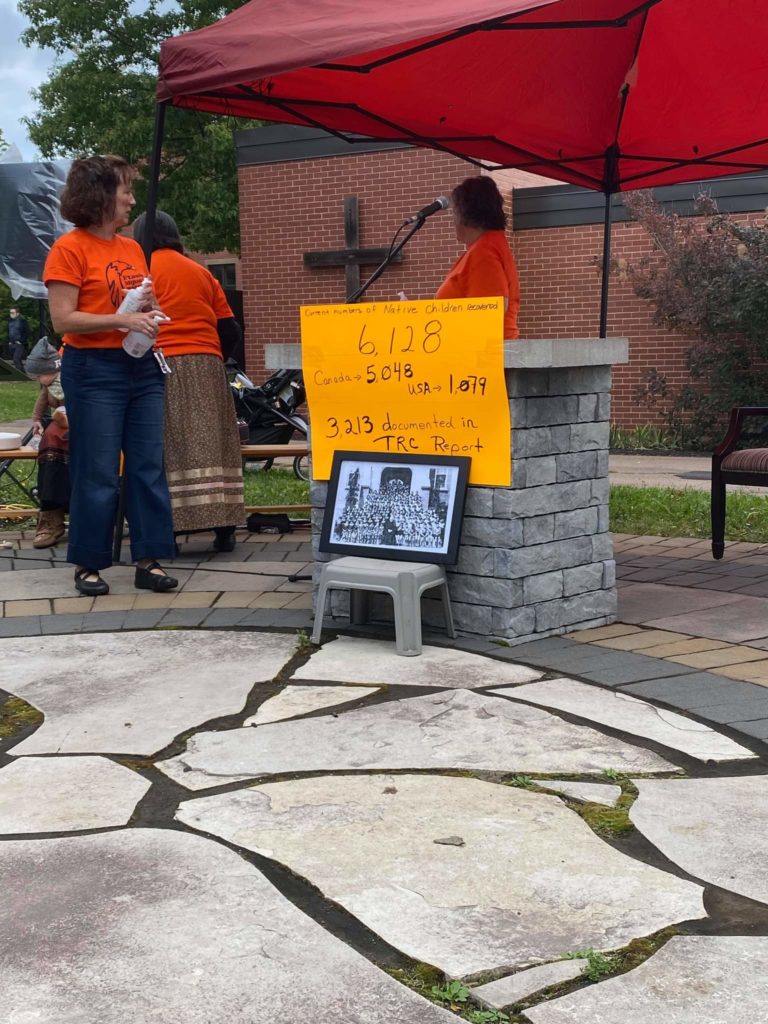By Dana Chatterjee
“It is not ‘forgive and forget’ as if nothing wrong had ever happened, but ‘forgive and go forward’, building on the mistakes of the past and the energy generated by reconciliation to create a new future.†(Alan Paton)
History:
Six-year-old Phyllis Webstad wore an orange shirt that her grandmother had gifted her for her first day at St Joseph’s school in Williams Lake BC. Her excitement in joining a new school was immediately replaced by fear, as she was stripped off her clothes and her hair was forcefully cut. Why? Her only ‘fault’ was that she was indigenous. “The colour orange has always reminded me of that and how my feelings didn’t matter, how no one cared and how I felt like I was worth nothing.†(Phyllis). Many children were stripped from their homes and placed into the residential school system to destroy all aspects of Indigenous cultures. They were prohibited from speaking their own language, strict timetables were enforced, many were assaulted or killed and several died trying to escape.
Imagine if the initial years of your life is filled with torture and grief instead of happy memories. At the age when you are truly supposed to enjoy life, these children were wishing they didn’t exist. Being little children, they didn’t even understand why this was happening to them but they forgot what freedom and compassion felt like. Their childhood was scarred beyond repair and they didn’t deserve that.
Truth and Reconciliation day is celebrated to educate and remind Canadians about the history of residential schools, honour the victims and celebrate the survivors. On this day we come together to build strong relations among the Indigenous and the Non-Indigenous people so that the past atrocities aren’t repeated again. This is a day for survivors to be reaffirmed that they matter, and so do those who have been affected because Every Child Matters, even if they are an adult, from now on.
There were 140 federally run Indian Residential Schools that operated in Canada between 1831 and 1998. The last school closed only 23 years ago. Survivors advocated for recognition and demanded accountability for the lasting legacy of harm caused. These efforts culminated in:
- the Indian Residential Schools Settlement and Agreement
- the establishment of the Truth and Reconciliation Commission
- the creation of the National Centre for Truth and Reconciliation
In preparation for this day of reflection and attempt at reconciliation, a plethora of events was held at UPEI on Tuesday, September 28th to celebrate the first official National Day for Truth and Reconciliation. The day started off with a smudge ceremony, followed by singing and drumming with the heartbeat of Epekwitk, a tree planting, jingle dress dancing and finally a presentation by Elder-in-Residence Dr Judy Clark where she shared her knowledge of residential schools and reflected on her experiences in Indian Day School.  Additionally, a five-day national virtual event from September 27 to October 1, was organized by the National Centre for Truth and Reconciliation. It focused on historical workshops, exclusive video content, and activities, all supported by artistic and cultural performances by First Nations, Métis, and Inuit artists.
We cannot change the past, but we can ensure that inequality doesn’t prevail. Equality and justice shouldn’t be mere words, but actually believed and practised. There should be no line of difference and disparity amongst people and acknowledging this day is the first step towards that. For, in the end, we are all one people and one nation and our strength lies in our diversity.
References:
https://www.officeholidays.com/holidays/canada/national-day-for-truth-and-reconciliation
https://www.orangeshirtday.org/phyllis-story.html
https://www.orangeshirtday.org/about-us.html
https://www.canada.ca/en/canadian-heritage/campaigns/national-day-truth-reconciliation.html
